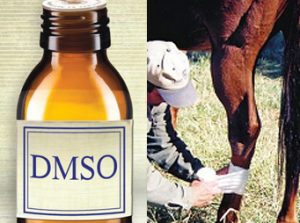DMSO – So Many Ways To Help Your Horse
Click here to read the complete article274 – July/Aug, 2018
By Heather Smith Thomas
 Most trainers and horse owners rely on various types of medications for treating leg injuries and soreness in equine athletes. One favorite “all purpose” product is DMSO (dimethyl sulfoxide). It has dozens of uses and many horsemen swear by it, since it seems to have a high margin of safety and very few side effects. Some practitioners have used it for nearly every medical condition. By itself, it reduces pain, swelling and inflammation. DMSO is often used in combination with other medications because it readily penetrates body tissues and can take another medication with it.
Most trainers and horse owners rely on various types of medications for treating leg injuries and soreness in equine athletes. One favorite “all purpose” product is DMSO (dimethyl sulfoxide). It has dozens of uses and many horsemen swear by it, since it seems to have a high margin of safety and very few side effects. Some practitioners have used it for nearly every medical condition. By itself, it reduces pain, swelling and inflammation. DMSO is often used in combination with other medications because it readily penetrates body tissues and can take another medication with it.
WHAT IS DMSO?
Dimethyl sulfoxide is a colorless liquid (also available in gel form) with an odor somewhat like rotten onions after it is applied to the body. Although it looks like tap water, DMSO is slightly syrupy and has an aftertaste like oysters or garlic; if you touch it, you can immediately taste it. Sometimes just breathing the air where DMSO has been used can produce this taste in your mouth. When metabolized by the body it is broken down by oxidation into MSM (methylsulfonyl-methane) or reduced to DMS (dimethyl sulfide) and excreted in urine and feces. DMS is also eliminated through the skin and lungs (and can be smelled on the breath) and is responsible for the characteristic odor. This odor may persist up to 72 hours after a single dose of DMSO in a human or animal patient.
DMSO is hydroscopic, which means it attracts water, and can draw fluid out of body tissues. It freezes at a higher temperature than water, becoming solid at about 50 degrees Fahrenheit. Once it becomes solid it takes a while to liquify again, but can be readily thawed by placing the container of frozen DMSO in warm water. When working with DMSO on a cool day, it must be protected from getting cold.
It produces heat (temporarily) when mixed with water, and has a lower freezing point. It is soluble in many different solvents such as alcohol, acetone, chloroform or ether. A 2.5% solution of DMSO is isotonic, which means it has the same number of particles as saline or blood, and has the same tonicity (effective osmotic pressure equivalent) as serum.
Click here to read the complete article274 – July/Aug, 2018










